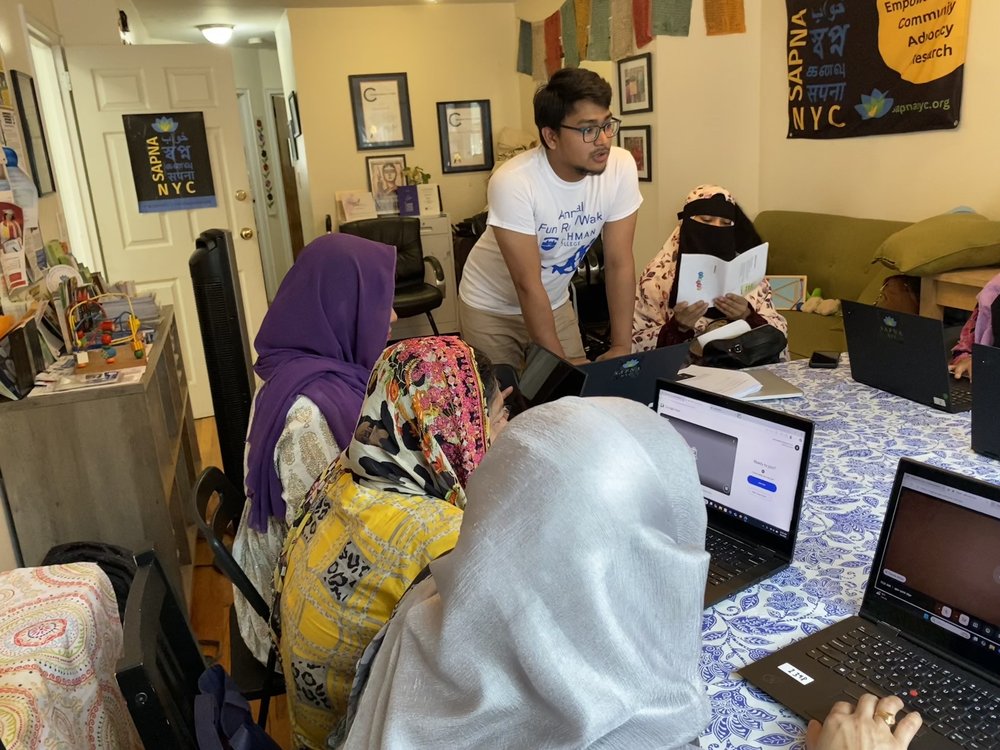NYC immigrants want safer, better-paying work. A major hurdle: building digital skills.
Aug. 26, 2025, 5:01 a.m.
Few resources exist to help immigrants navigate an increasingly digital world.

Inside a small house in the Parkchester neighborhood of the Bronx, seven Bangladeshi women sat around a large table earlier this month, trying to figure out how to mute themselves on Zoom.
It was the first time many were using the video conferencing software.
“ We should always stay mute until our turn to talk,” instructor Sakib Shikder told the class. He switched between Bengali and English as he went through the lesson.
Sapna NYC, a nonprofit aimed at empowering South Asian immigrant women, offers classes on how to use Zoom, set up a Gmail account, attach a document to an email and use calendar reminders. Some students say they’re using spreadsheet formulas to organize their catering business. Others are using Zoom to communicate with their families.
Advocates say learning digital skills can help immigrants find higher paid and safer work, apply for benefits online such as low-cost Metro Cards or better communicate with their kids’ schools. But they say despite demand, there are few programs in the city that teach digital literacy to immigrant communities, where residents face language barriers and often work in the informal economy.
“It's a vital tool that can transform and improve their lives and help them negotiate better wages,” said Ligia Guallpa, executive director of the Worker’s Justice Project, which is training domestic workers on tech skills. Guallpa said immigrant women are learning to use language translation apps to communicate with their employers or finding work online rather than by word of mouth.
“ We have been teaching how to use chatGPT to respond to their employers in a professional way,” Guallpa said. She said others “ feel comfortable accepting certain jobs because now they have a GPS and they know how to use GPS to get there easily without getting lost.”
Sapna NYC, which is based in the Bronx, teaches three levels of computer classes and already, 40 students are on the wait list for the next level, which hasn’t been rolled out yet. About 200 students have graduated from the classes, which began in 2019.
“ Being able to use the internet, like even just basic Google searches opens up so much information for families, whether it's looking for food pantries or being able to access MyChart for their doctor's appointment or the student portals for school. Being able to look up different fun activities to do with your kids, buy tickets online,” said Diya Basu-Sen, executive director of Sapna NYC.
“It's so many tiny little things that we don't think about that just makes life so much easier.”
Advocates said the need for immigrant communities to acquire digital skills is urgent given the Trump administration intensifying immigration enforcement, ending temporary protected status for certain groups of people and shutting off food stamps for legal refugees.
Learning to navigate the internet can help immigrant communities check the status of their asylum cases online or learn about their rights, advocates said.
“Not being able to use the technology, it makes them be dependent on somebody,” said Yadira Sanchez, coordinator of health and safety for the Worker’s Justice Project. “And not being able to resolve certain things.”
Eli Dvorkin, editorial and policy director for the Center for an Urban Future, said while the city boasts an array of resources that offer coding classes or advanced computing skills, the needs in some communities are often more basic.
“The most overlooked gap right now, the area where the most new progress is really needed is around digital literacy, tech skills, and computing education,” Dvorkin said. He recently authored a report that found the Bronx has the lowest rate of households with access to broadband or computers at home.
“If you're not fully confident in your basic use of a computer, you're not ready for, let's say, an introductory coding class taught for free by the New York Public Library. Those programs are popular, but there's a lot of residents that aren't really ready for that. And that underscores the need for a full continuum of tech education,” he said.
Sapna NYC said connecting the immigrant community to technology can also help those who are newer to the country feel less isolated.
Faydia Jahan, 52, said she now uses Zoom daily to speak with her daughters who are away at college in different states.
“I’m very happy to take this class because I know more and more things about the computer,” she said.
NYC pushes to get migrants work permits, but shelter evictions could complicate the process Many migrant kids at NYC schools are new to English. They're finding creative ways to learn.